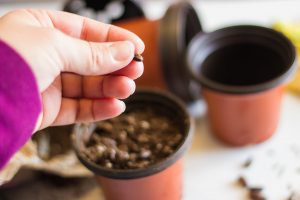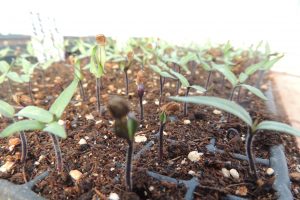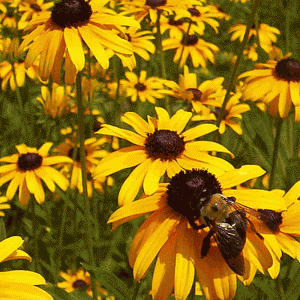Yes You Can Grow Perennials from Seed

Planting Seeds
Problem: Your vision is vast, but your budget is tiny.
Solution: Create the large swaths of flowering perennials that fulfill your garden dreams without spending a fortune, by choosing varieties that grow easily from seed.
Herbaceous perennial plants—those that live from year to year, regenerating from the roots each spring—are often propagated by dividing big clumps of roots into sections. The sections can be potted and sold or, in the case of the home gardener, planted elsewhere or given away to friends.
So why do gardeners opt to grow perennial flowering plants from seed, rather than purchase them as a potted plant?
1. They Want to Save Money. For the cost of a
pack of seeds, you might end up with hundreds of
plants. This is a powerful incentive for an ambitious
gardener on a tight budget. Many of the perennials
in your nursery’s inventory have, in fact, been
grown from seed.
2. They Want to Start a Meadow.

Wildflower Meadow
Wildflowers that inhabit meadows are tough,
tenacious, and among the easiest perennial plants to
start from seed. Black-eyed Susans, coneflowers,
asters, lobelias, milkweeds, and native grasses will
create a colorful scene that will lure many species
of birds, butterflies, and bees to your plot.
3. They like Surprises. Vegetatively propagated
cultivars (those that have been divided or started from cuttings) are perfectly uniform. This can be desirable—if you don’t like surprises. For those who welcome the unexpected, seedlings can provide a
little fun. After all, many new perennial cultivars are discovered when a seedling produces flowers of surprising hues, or with unusual growth habits.
4. It’s Not Difficult. Although it’s true that some perennials (orchids, for example) can be tricky to grow from seed, others are almost foolproof. Some even flower the first year from seed.
What You Should Know
Patience Pays Off: Perennials are typically slower
to germinate than annual flowers. Zinnias and
marigolds pop up in a matter of days, while some
perennials may take up to a month to sprout.
Timing is Not as Critical: Because you’re growing
plants that will live more than one year, starting them
in early spring is not as essential with perennials. As
long as your plants get a sturdy enough start to make it
through the winter, they will bloom—if not the first
year, then the second.
Soil Mix Should be Well Draining: Panayoti
Kelaidis, curator at Denver Botanic Gardens,
recommends adding clean, washed sand to soilless
potting mix at a ratio of 1 part sand to 2 parts soil mix,
to improve drainage.
Most Seeds Require Light: Sow several seeds in a
single pot, scattering them evenly on the surface.
Cover them lightly, if at all.

Seedlings In the Light
Maintain Optimal Germination Conditions:
Because germination will take some time, it is
essential that the soil mix remain moist for a period of
days to weeks. Try topping the soil mix with a layer of
sterile aquarium gravel and sowing tiny seeds right on
top (they will fall into crevices) to help keep the seeds
evenly moist. Larger seeds can be sown directly on the
soil mix and top-dressed with a light layer of gravel.
Some growers sow seeds in pots and place them in
clear, loosely tied plastic bags. Others mist frequently.
Others simply mimic nature as closely as possible,
placing the pots outdoors and letting the natural
freeze-thaw cycles take care of the rest.
Water Gently: Water seeds that have not yet
germinated and newly emerged seedlings with a very
gentle spray or mist. Or set pots into a basin and allow
them to absorb water from below.
“Prick Out” Seedlings and Give Them Space:
Very carefully, pull tender seedlings apart and place
each in its own pot after seedlings develops their first
true leaves. Protect them from direct sun until they
size up. This can take 2 weeks, or 2 months,
depending on the species.
Ten to Try
Anise hyssop (Agastache): Seeds can germinate in
less than a week (after stratification) but can also take as long as a
month. Plants grow up to 3 feet tall and sport
spikes of flowers that are irresistible to bees and
butterflies. Zones 2-8.
Black-eyed Susan (Rudbeckia)

Black Eyed Susan
Seeds germinate in
about 3 weeks. Plants are tolerant of heavy soils,
and the cheerful flowers bloom throughout the
summer. Grows to 24 inches tall. Zones 1-12.
Blanket Flower (Gaillardia): Seeds can take up to
three weeks to sprout. Keep them warm (70-75°F)
until germination occurs. Compact plants usually
bloom the first year from seed, and the warmhued
flowers attract butterflies. Zones 2-10.
Columbine (Aquilegia):Â Â Sown in winter, native columbines (A. caerulea and A. canadensis) germinate reliably in spring and
bloom the next year. Â Its natural growth in rocky areas makes it a good choice for rock gardens. Zones 3-10.
Coneflower (Echinacea): Sow seed (after stratifying) in a warm
location (about 70°F) and germination should
occur within 3 weeks. Seed can also be sown
outdoors in the summer months. Keep plants weeded as they need room to be established. Plants will take a
year or more to reach blooming size. Zones 4-9.
Iceland Poppy Direct sow in early spring, planting on the surface of the soil since this seed needs light to germinate. Keep the soil lightly moist until germination, which should occur within 10-14 days. This plant often self-sows, and is highly attractive to bees, butterflies, and birds.
Salvia (Salvia farinacea):Â It germinates in 1 to 2 weeks (30 days of stratifying is helpful)Â and can reach blooming size the first year. This plant grows very quickly and needs little care, though watering during dry weather will improve its blooming. Mature plants tolerate heat and drought, as well as thriving in sandy or rocky soils. The blue to purple flowers are attractive to bees and
butterflies. Zones 2-12.
Garland Daisy (Chysanthemum)Â Direct sow in spring after the last chance of frost, sowing on the surface of the soil; press the soil down lightly and keep moderately moist until germination, which should take place within 10-14 days. It will self-seed and spread easily, but volunteer plants can easily be removed if not wanted. This plant also grows well as a container plant if it has good drainage. Zones 2-12
None-So-Pretty (Silene): Direct sow in late fall, pressing into the surface of the soil since this plant needs light to germinate. For spring planting, mix the seeds with moist sand and store in the refrigerator for 60-90 days before planting. Keep the soil lightly moist until germination. It germinates in about 2-4
weeks. Mature plants grow well in drought and poor soil, though they will bloom best with occasional watering in especially dry weather. They also tolerate rocky soil or gravel. This plant will readily self-seed unless cut back after flowering has finished.  Zones 1-12.
Tickseed (Coreopsis): Germination should occur in
two weeks or less (after stratification) Plants usually can be counted
on to produce their characteristically profuse
blooms the first year, if sown in spring. Zones 4-9.
Used gratefully with permission from Home Garden Seed Association

